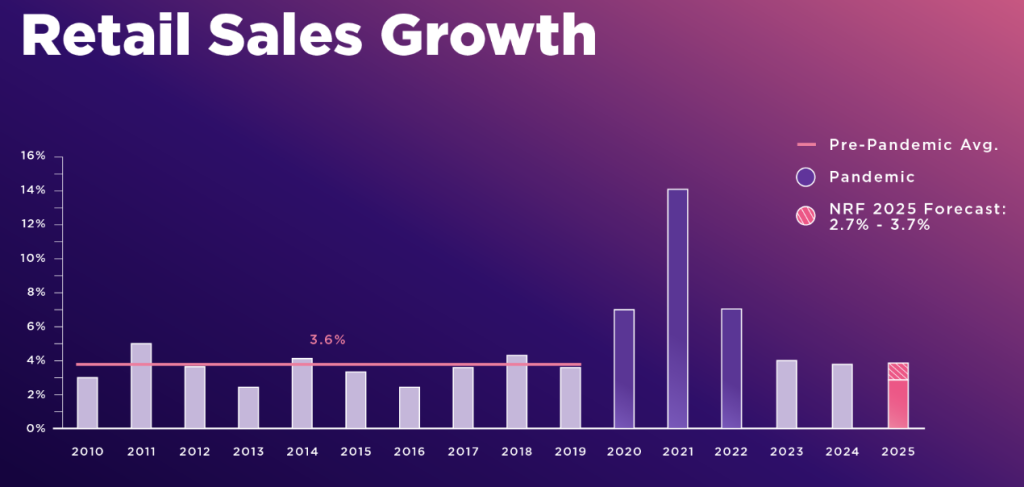The National Retail Federation (NRF) forecasts that 2025 retail sales will grow between 2.7 percent and 3.7 percent compared to 2024 and deliver sales between $5.42 trillion and $5.48 trillion.
The NRF presented its forecast during a presentation it gave at its Fifth Annual State of Retail & the Consumer virtual event on the Health of American Consumers and the Retail Industry.
“Overall, the economy has shown continued momentum so far in 2025 — bolstered by low unemployment and real wage gains — however, significant policy uncertainty is weighing on consumer and business confidence,” said NRF President and CEO Matthew Shay. “Still, serving customers will remain retailers’ top priority no matter what the economic environment.”
The NRF’s 2025 sales forecast compares with 3.6 percent annual sales growth to $5.29 trillion dollars in 2024. Its 2025 forecast also aligns with the 10-year pre-pandemic average annual sales growth of 3.6 percent.
Non-store and online sales, included in the total figure, are expected to grow between 7 percent and 9 percent year-over-year to range between $1.57 trillion and $1.6 trillion. By comparison, non-store and online sales grew 8.1 percent for a total of $1.47 trillion in 2024.
The NRF expects GDP growth to decline nearly 2 percent in 2025, down from GDP growth of 2.8 percent in 2024 and below the trend of the past few years.
“Any way you look at it, a lot is riding on the consumer,” offered NRF Chief Economist Jack Kleinhenz. “While we do expect slower growth, consumer fundamentals remain intact, supported by low unemployment, slower but steady income growth, and solid household finances. Consumer spending is not unraveling.”
Kleinhenz added that while consumer confidence is declining mainly due to lingering inflation and consumers’ anxiety over tariffs, that does not mean there will be an immediate drop in consumer spending.
“It’s the hard data on employment, income and tariff-induced inflation — not consumer sentiment — that supports our view of a slower trajectory for consumer spending,” he noted.
With the implementation of tariffs, the NRF expects PCE inflation during 2025 to remain at its current level of about 2.5 percent. Overall, household balance sheets seemin good shape. Delinquencies on auto loans and credit card payments have risen but remain in line with the pre-pandemic trend. Kleinhenz said the consumer credit picture should remain healthy as long as the labor market remains solid.
The NRF’s calculation of retail sales excludes auto dealers, gas stations and restaurants to focus on core retail. The NRF based its 2025 retail sales forecast on economic modeling that considers various indicators, including employment, wages, disposable income, consumer credit, and previous retail sales. The NRF publishes forecasts and other analyses using data from a range of U.S. government sources, including the CNBC/NRF Retail Monitor, powered by Affinity Solutions.
Go here to read frequently asked questions regarding the NRF’s annual forecast.
Infographic courtesy NRF











